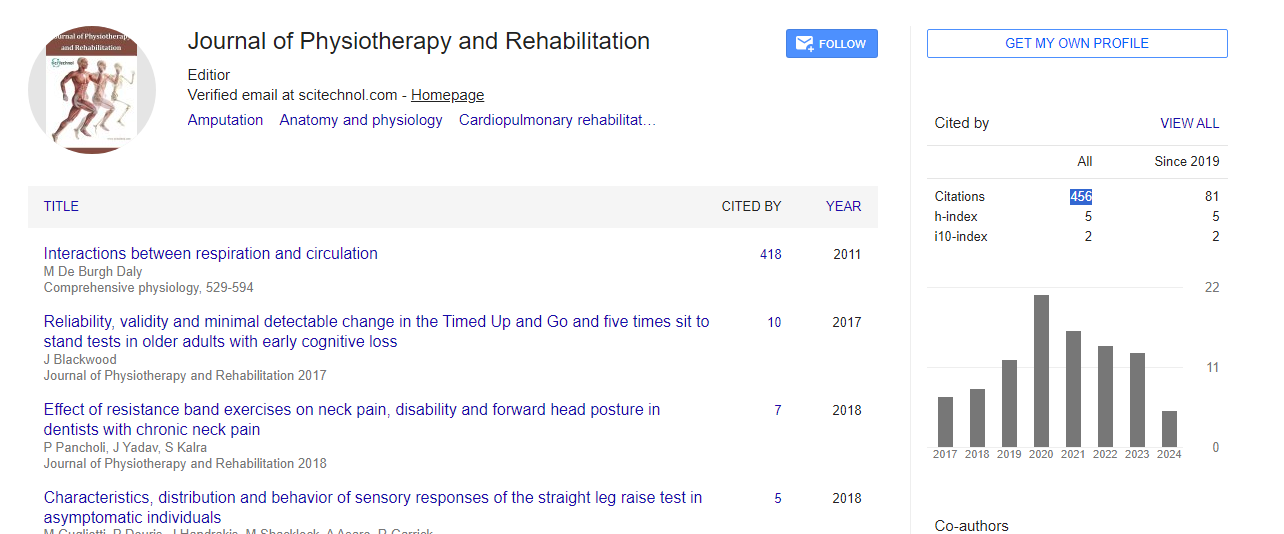Perspective, J Physiother Rehabi Vol: 7 Issue: 2
Successful Rehabilitation Techniques in Physiotherapy
Renata Minta Owens*
Department of Physical Therapy, New York Institute of Technology, United States of America
*Corresponding Author: Renata Minta Owens
Department of Physical Therapy, New York Institute of Technology, United States of America
E-mail: renataminowen@nyit.edu
Received date: 22 March, 2023, Manuscript No. JPTR-23-99195;
Editor assigned date: 24 March, 2023, Pre QC. JPTR-23-99195 (PQ);
Reviewed date: 15 April, 2023, QC No. JPTR-23-99195;
Revised date: 22 April, 2023, Manuscript No. JPTR-23-99195 (R);
Published date: 28 April, 2023, DOI: 10.4172/JPTR.1000132
Citation: Owens RM (2023) Successful Rehabilitation Techniques in Physiotherapy. J Physiother Rehabi 7:2.
Description
Physiotherapy is a vital aspect of rehabilitation for individuals who suffer from injuries or disabilities that affect their ability to function in daily life. Physiotherapists design treatment plans and rehabilitation programs tailored to the unique needs of their patients, with the aim of restoring their mobility, strength, and independence.
Successful rehabilitation techniques
Manual therapy: Manual therapy is a hands-on approach used by physiotherapists to manipulate and mobilize joints, soft tissues, and muscles. This technique involves various movements, including massage, stretching, and joint mobilization, to alleviate pain, improve joint mobility, and reduce muscle tension. Manual therapy is often used in combination with other physiotherapy techniques, such as exercise therapy, to enhance their effectiveness.
Exercise therapy: Exercise therapy is a core component of physiotherapy rehabilitation programs. This technique involves the use of exercises to improve the patient's strength, flexibility, balance, and endurance. Exercise therapy can be tailored to the patient's specific needs and can include a variety of exercises such as stretching, strengthening, and conditioning exercises. The physiotherapist may also use specialized equipment like resistance bands, weights, and treadmills to enhance the effectiveness of the exercise program.
Electrotherapy: Electrotherapy is a rehabilitation technique that uses electrical currents to stimulate muscles and nerves. This technique can be used to alleviate pain, reduce muscle spasm, and promote muscle relaxation. Electrotherapy techniques used in physiotherapy include Transcutaneous Electrical Nerve Stimulation (TENS), Interferential Current Therapy (IFC), and Neuromuscular Electrical Stimulation (NMES).
Aquatic therapy: Aquatic therapy involves the use of water for therapeutic purposes. This technique is particularly useful for patients who have difficulty with weight-bearing exercises. The buoyancy of the water supports the patient's weight, reducing the load on the joints and facilitating movement. Aquatic therapy can be used to improve range of motion, strength, and balance, and reduce pain.
Functional training: Functional training is a rehabilitation technique that focuses on training the patient to perform activities of daily living. This technique involves the use of exercises that mimic real-life activities, such as walking, climbing stairs, or reaching for objects. The physiotherapist designs a training program that is specific to the patient's goals and abilities, with the aim of improving their independence and quality of life.
Balance training: Balance training is a rehabilitation technique used to improve the patient's balance and coordination. This technique is particularly useful for patients who have suffered from a fall or have difficulty with mobility. The physiotherapist may use exercises that challenge the patient's balance, such as standing on one leg or walking on uneven surfaces. Balance training can help reduce the risk of falls and improve the patient's confidence in their ability to move around safely.
Conclusion
Physiotherapy is a valuable tool for the rehabilitation of individuals who have suffered from injuries or disabilities that impact their daily life. Physiotherapists use a variety of techniques, including manual therapy, exercise therapy, electrotherapy, aquatic therapy, functional training, and balance training, to design rehabilitation programs tailored to the patient's needs. The successful implementation of these rehabilitation techniques can improve the patient's mobility, strength, and independence, helping them to achieve their goals and improve their quality of life.
 Spanish
Spanish  Chinese
Chinese  Russian
Russian  German
German  French
French  Japanese
Japanese  Portuguese
Portuguese  Hindi
Hindi 